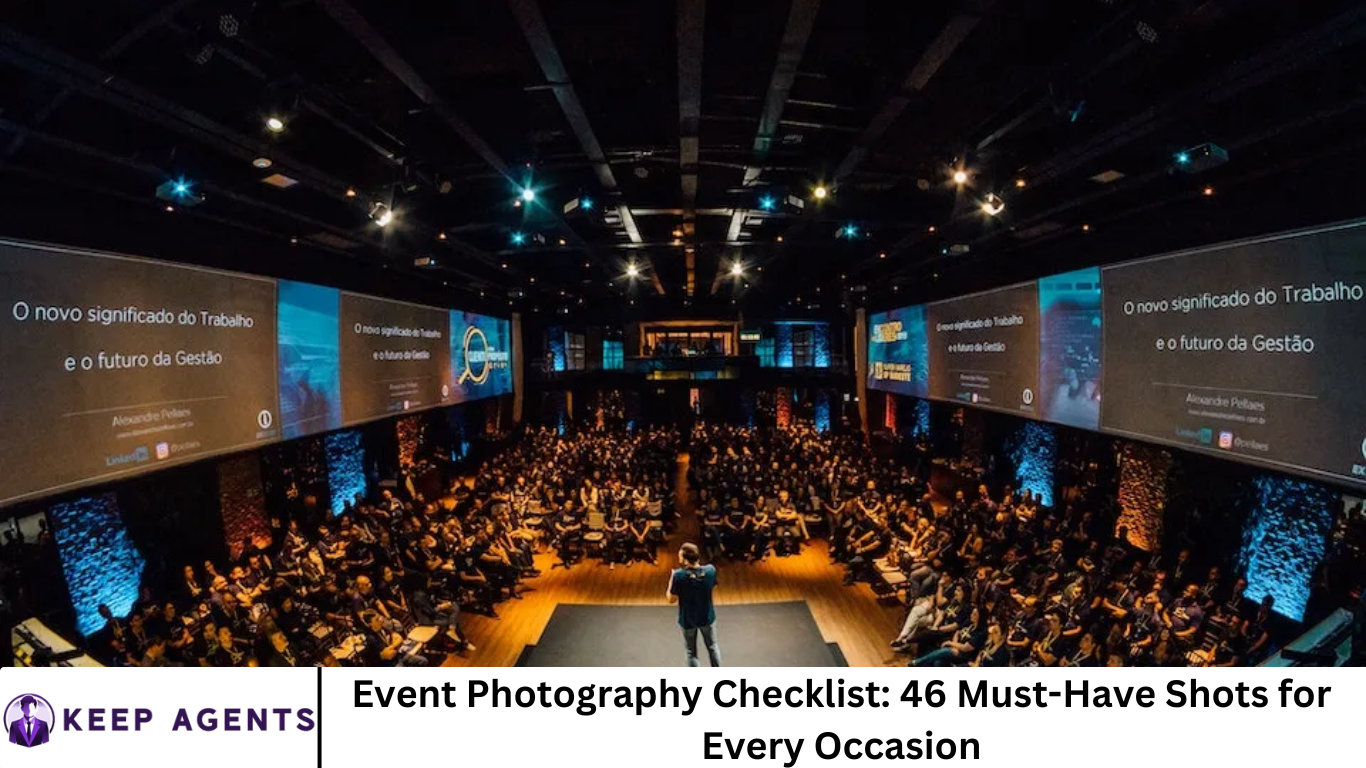Event photography is more than just pointing and shooting—it’s about capturing the energy, emotion, and narrative of the event. Whether you’re photographing a corporate conference, a wedding, a birthday party, or a music festival, knowing which moments to capture is key to telling a compelling story through images.
A well-structured event photography checklist ensures no critical moment goes unnoticed. It helps photographers stay organized and aligned with client expectations. This guide will walk you through 46 must-have shots that every event photographer should aim for, categorized for easy reference. Let’s dive in!
More Read: 10 Unique Ways to Capture Your Love: Anniversary Photoshoot Ideas
Why You Need an Event Photography Checklist
A comprehensive shot list offers several benefits:
- Clarity: Know exactly what to capture without relying solely on memory.
- Consistency: Ensures your coverage is thorough across multiple events.
- Communication: Aligns expectations between client and photographer.
- Efficiency: Helps manage time and prioritize key moments.
Whether you’re a seasoned pro or just starting out, having a checklist guarantees that nothing essential slips through the cracks.
General Must-Have Event Photography Shots
These universal shots apply to virtually any type of event:
- Venue Exterior: Set the scene by capturing the event location from the outside.
- Venue Interior (Before Guests Arrive): Show the setup and decorations.
- Signage & Branding: Important for corporate and branded events.
- Guest Arrival: Capture people entering and greeting one another.
- Registration Area: Particularly vital for conferences and seminars.
- Wide Shot of the Crowd: Provides scale and atmosphere.
- Candid Guest Interactions: Natural moments tell the best stories.
- Food & Drink Displays: Highlight catering and presentation.
- Staff & Vendors at Work: Showcase the team behind the scenes.
- Event Overview from Elevated Angle: Get a bird’s-eye view if possible.
Corporate Event Photography Checklist
Corporate events demand professionalism and detail. These shots are essential:
- Name Badges and Lanyards: Document attendee credentials.
- Networking Moments: Capture key interactions.
- Speakers on Stage: Highlight keynotes and panelists.
- Audience Reactions: Smiles, applause, and engagement.
- Q&A Sessions: Interaction between audience and speakers.
- Breakout Sessions or Workshops: Showcase participation.
- Product Displays or Demos: Especially important at expos.
- Company Branding Throughout Venue: Logos, banners, etc.
- VIP Guests or Executives: Important for internal records.
- Award Presentations: Capture the moment and the awardee.
Wedding Photography Checklist
Weddings are full of emotional, once-in-a-lifetime moments:
- Bride & Groom Getting Ready: Hair, makeup, and suits.
- Detail Shots (Rings, Dress, Shoes): Close-ups of key items.
- First Look: That magical first moment together.
- Ceremony Venue Before Guests: Ambience and decor.
- Walking Down the Aisle: A core emotional moment.
- Vows & Ring Exchange: Close-ups and candid angles.
- The Kiss: A must-have.
- Family & Group Portraits: Organize ahead of time.
- Reception Details: Centerpieces, cake, table settings.
- First Dance and Speeches: Capture both the dancers and crowd reactions.
Birthday & Social Event Photography Checklist
From kids’ parties to milestone birthdays, here are key shots:
- Decorations & Themed Elements: Balloons, signs, etc.
- Guest of Honor Arrival: Reactions and greetings.
- Games or Entertainment: Kids playing or live performances.
- Cake Cutting: Iconic and often anticipated.
- Gift Opening: Genuine reactions.
- Group Photos: With friends and family.
- Dance Floor Fun: Energetic and candid shots.
- Candid Laughter: Nothing beats natural emotion.
- Toasts or Speeches: Capture the person and the listeners.
- Farewell Moments: Hugs and goodbyes.
Music, Festival, and Concert Photography Checklist
These events require a different focus and often challenging lighting:
- Performer Portraits: Solo and group shots on stage.
- Crowd Energy: Fans dancing, cheering, and waving.
- Lighting and Stage Effects: Lasers, smoke, and pyrotechnics.
- Behind the Scenes: Roadies, setups, and downtime.
- VIP and Media Areas: Exclusive access moments.
- Headliner Closing Shot: Grand finale with lights and confetti.
Tips for Getting Every Shot
- Use a Checklist App: Tools like Trello or Google Keep help stay organized.
- Scout the Venue Early: Understand lighting and angles.
- Shoot in RAW: Allows greater flexibility in editing.
- Bring Backup Gear: Extra batteries, lenses, and cards are essential.
- Communicate with Organizers: Know the schedule and VIPs.
- Stay Discreet but Present: Blend in while staying alert.
- Tag & Deliver Promptly: Quick turnaround improves client satisfaction.
Frequently Asked Question
What is an event photography checklist and why is it important?
An event photography checklist is a curated list of key moments and shots that a photographer needs to capture during an event. It ensures comprehensive coverage, aligns expectations between the client and photographer, and helps prevent important moments from being missed.
How can I customize this event photography checklist for different types of events?
You can tailor the checklist by focusing on the specific sections relevant to your event type—such as weddings, corporate events, or concerts. Remove irrelevant shots and add unique moments that are specific to your event’s theme, schedule, or client preferences.
Should I share my event photography checklist with my photographer?
Absolutely. Sharing the checklist with your photographer is key to effective communication. It ensures they understand your priorities, timing, and any special requests, helping them deliver results that match your expectations.
What equipment should a photographer bring to cover all checklist shots?
Photographers should bring multiple lenses (wide, telephoto, and prime), extra batteries, memory cards, external flashes, and backup gear. A dual-camera setup is helpful for switching between wide and close-up shots without wasting time.
How early should a photographer arrive to capture setup shots?
Ideally, photographers should arrive 1–2 hours before the event starts. This allows time to capture venue shots, decor, and behind-the-scenes activity before guests arrive and the event begins.
What’s the best way to stay organized while using a shot list during a live event?
Use digital tools like Trello, Notion, or Google Keep on your phone or tablet. Alternatively, print a hard copy and check off shots as you go. Assign priority levels to must-have shots so you can adjust if time is limited.
Can this checklist be used by amateur photographers or is it only for professionals?
This checklist is useful for photographers of all experience levels. Whether you’re a professional or an enthusiast, having a structured list helps you stay focused, build your skills, and deliver a polished final product.
Conclusion
A solid event photography checklist is your blueprint for success. It helps you cover all essential angles, exceed client expectations, and build a stunning portfolio. While every event is unique, these 46 must-have shots form a strong foundation you can customize for any occasion. Whether you’re covering an elegant wedding or a buzzing corporate expo, preparation is the key to capturing unforgettable moments. Need a printable checklist or downloadable template? Let us know, and we can provide one!


